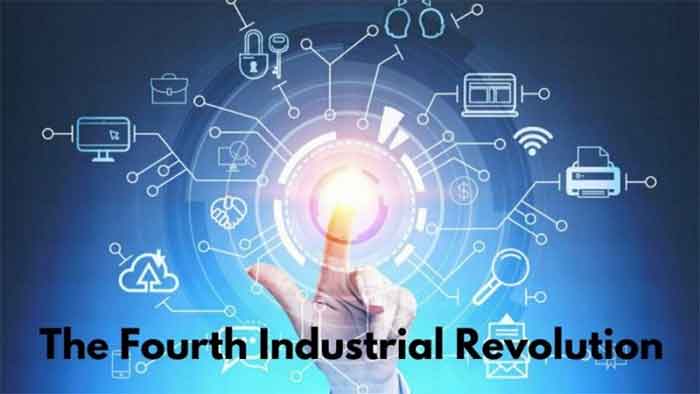
Series Note: We are in the middle of an unprecedented crisis as the Covid-19 pandemic, and the lockdowns implemented in response, continue to deliver a series of economic, social and psychological shocks to the world. In this time of chaos, some of the world’s most powerful interest groups have stepped forward claiming that this crisis presents an opportunity to ‘reset’ the world’s systems.
Leading the charge is Geneva-based World Economic Forum (WEF) with its ‘Great Reset’ initiative, an ambitious plan to shape the contours of the post-Covid world. This three-part series critically examines the origin, workings and implications of the Great Reset agenda, which its critics have denounced as the corporate capture of global governance and the global commons.
The first part focuses on the ‘Fourth Industrial Revolution,’ which forms the centerpiece of the Great Reset, and its implications for the world and for India, particularly its impact on employment.
Why is the Indian government promoting job-destroying ‘smart’ automation when the country is reeling from the worst unemployment crisis in recent history?
In October 2018, the World Economic Forum (WEF) opened its ‘Centre for the Fourth Industrial Revolution in India’ to work in collaboration with the Government of India. Part of a network of such centres being set up across the world, it is located in Navi Mumbai, and was unveiled by none other than Prime Minister Narendra Modi.
But, what exactly is the ‘Fourth Industrial Revolution,’ the catchphrase that has been doing the rounds in business, tech and policy circles, which in recent years has been actively popularised by Klaus Schwab, founder and executive chairman of the WEF?
The origin of the term itself can be traced back to a 2013 initiative by the German government known as ‘Industrie 4.0.’ It was a strategic policy bid to harness the rapid convergence of digital technologies, manufacturing processes, logistics and human systems to build ‘smart factories’ or ‘cyber-physical production systems,’ with the stated purpose of preserving Germany’s global manufacturing dominance well into the 21st century.
However, this factory-centric understanding of new technologies obscure their true significance, says Schwab, who describes this shift as an Industrial Revolution in its own right. According to this view, the First Industrial Revolution, starting from the 1750s, used steam power to mechanise production; the Second advanced this by using electric power to scale up production in the beginning of the 20th century; while the Third deployed electronics and IT to automate production. Now, he says, a Fourth Industrial Revolution is building on the Third, the information revolution that has been occurring since the last century.
Schwab describes it as being “characterised by a fusion of technologies that is blurring the lines between the physical, digital, and biological spheres.” However, unlike previous industrial revolutions, it is evolving at an exponential rather than a linear pace. “The speed of current breakthroughs has no historical precedent,” writes Schwab, and it is leading to “a technological revolution that will fundamentally alter the way we live, work, and relate to one another. In its scale, scope, and complexity, the transformation will be unlike anything humankind has experienced before.”
Schwab identifies a set of emerging technologies that are driving this change, including Artificial Intelligence, robotics, Internet of Things, autonomous vehicles, 3-D printing, nanotechnology, biotechnology, materials science, energy storage, and quantum computing.
Since this technological shift in production is “disrupting almost every industry in every country,” it also entails a paradigm shift in terms of logistics, trade and exchange, which Schwab calls ‘Globalisation 4.0.’ It refers to new frameworks for international cooperation that he says are needed to manage and adapt to the unprecedented pace and breadth of technological change unleashed by Industry 4.0. Announcing the theme of the WEF’s 2019 meeting as “Globalization 4.0: Shaping a New Architecture in the Age of the Fourth Industrial Revolution”, Schwab declared, “Ready or not, a new world is upon us.”
The policy push in India
The WEF’s India Centre, set up in partnership with India’s apex planning body NITI Aayog, defines its mission as to, among other things, “accelerate the adoption of new technologies,” and to “co-design, test and refine governance protocols and policy frameworks to maximise the benefits and minimise the risks” from the Fourth Industrial Revolution. Headed by former Cisco executive Purushottam Kaushik, it has J. Satyanarayana, a former chairman of the Unique Identification Authority of India (UIDAI), as its chief advisor.
Milind Kulshreshtha, CEO of AIKairos, a company entrusted with running the Industry 4.0 implementation and education programme in India, recently listed the major policy moves by the Central government to advance this agenda. Firstly, the NITI (National Institution for Transforming India) Aayog, has been designated the nodal agency to interact with the World Economic Forum for “elaborating the new policy frameworks for emerging technologies” (The terminology is intriguing – ‘nodal agency’ in bureaucratic terms refers to one entrusted with implementation or supervision of a policy or programme. This suggests a subordinate role for the NITI Aayog, India’s apex planning body, in shaping India’s own policy on Industry 4.0).
The prime vehicle for Industry 4.0 implementation in India is the Samarth Udyog Bharat 4.0 (Smart Advanced Manufacturing and Rapid Transformation Hubs) under the Department of Heavy Industries. Underpinning this programme is the National Manufacturing Policy (NMP), which aims at enhancing the share of manufacturing in GDP to 25%, to achieve which “Industry 4.0 is the only way ahead,” according to Kulshreshtha.
Initiatives such as NMP, Make in India, Digital India and now, the Atmanirbhar Bharat Abhiyaan, add up to a wide-ranging and comprehensive policy framework and fiscal plan being put in place by the Centre for enabling Industry 4.0, which also follows a PPP (Public Private Partnership) model.
Of late, many government initiatives are being launched or rebranded as ‘Industry 4.0’ initiatives. For instance, in September 2019, the Railways announced what it claimed was “a pilot project to introduce Industry 4.0 in the country” at the Modern Coach Factory in Uttar Pradesh’s Raebareli.
The future of jobs
The implications of the Fourth Industrial Revolution are huge, and especially so for countries like India, with its large population. Take for example the all-too-crucial matter of employment, which will be directly hit by ‘smart’ automation, the defining feature of the Fourth Industrial Revolution. Here’s what some of the major studies of automation has to say on its potential impact on jobs:
The World Bank’s 2016 World Development Report, ironically titled ‘Digital Dividends,’ makes some alarming projections, estimating that 69 per cent of Indian jobs, 77 per cent of Chinese jobs, 47 per cent of US jobs, and an average of 57 per cent of jobs in OECD countries could be replaced by automated processes and robots.
The WEF’s own annual ‘The Future of Jobs’ report surveyed 12 key industries in 2018, and found that an average of 71% of the total task hours were performed by humans, compared to 29% by machines. The report forecasts that in just a span of four years (by 2022), this will change to 58% task hours performed by humans, versus 42% by machines.
A 2017 McKinsey study found that “50% of current work activities are technically automatable by adapting currently demonstrable technologies.” The study estimates that between 400-800 million jobs could be displaced by automation by 2030. It further states that India’s labour force is expected to grow by 30% or 138 million people by 2030, and the country can accommodate them only by creating enough jobs to offset the effects of automation.
A 2018 Federation of Indian Chambers of Commerce (FICCI) report on the future of jobs in India, modelled on the WEF reports, found that 20-35% jobs in the IT/BPM sector “will face an existential threat to their jobs” by 2022. Figures for other sectors are as follows: Automotive (10-15%), Textiles (15-20%), Banking & Financial Services (20-25%) and Retail (15-20%).
Lists of jobs that could disappear entirely due to automation in the next ten years feature not only predictable ones such as manufacturing workers, cashiers and bank tellers, but also telemarketers, stock traders and travel agents. More surprisingly, construction workers and waiters, and even traditional occupations such as farmers and soldiers, too are among those endangered.
A double disruption
The consequences of such rapid scaling up of automation are unthinkable, especially given the massive loss of jobs globally in the post-lockdown scenario, and all the more so in India’s case. Since automation is being implemented more rapidly and at a far greater a scale in industrialised countries, it will also seriously curtail labour emigration globally, with huge implications for the India’s emigrants, the world’s largest.
In 2017-18, the National Sample Survey Office’s periodic labour force survey (PLFS) report revealed that the Indian economy was already in deep trouble, with the country’s unemployment rate at its worst ever in 45 years. The findings were deemed so damaging that the Centre did not release the report, forcing two expert members of the National Statistical Commission to resign.
It was in this already bleak situation that the government implemented the national lockdown, which had a catastrophic effect on the economy. The Centre for Monitoring Indian Economy estimated that a staggering 14 crore people were rendered jobless by the national lockdown implemented in March 2020. Joblessness remains at record-breaking levels in India, and recent reports indicate that the country is nowhere close to an economic recovery; which, in this case, only means a return to a dismal pre-lockdown employment scenario.
In fact, the 2020 edition of the WEF jobs report admits that “automation, in tandem with the Covid-19 recession, is creating a ‘double-disruption’ scenario for workers,” the dual impact of which is likely to exacerbate inequality “in the absence of proactive efforts.” Even as the world reels from the biggest ever unemployment crisis in recent history, the WEF has only stepped up its efforts to accelerate automation in the post-lockdown scenario.
The WEF and industry lobby groups and consultancies claim that automation will also create many new jobs, which will compensate for jobs lost, but offers no firm basis for such optimism. All the rhetoric about ‘improved efficiencies’ and so on that surrounds it cannot obscure the unavoidable fact about automation: that its fundamental purpose is to reduce – if not replace altogether – the role of human labour in production.
It’s worth noting that, in the short term at least, these champions of the Fourth Industrial Revolution themselves concede that increasing automation will have a hugely negative impact on employment. And yet, neither the WEF, nor its partner NITI Aayog, nor other automation enthusiasts like FICCI, do not really explain why they want to “accelerate” automation despite this.
A top-down revolution
In his classic work, The Making of the English Working Class, the British historian E.P. Thompson wrote about the social havoc wreaked by the original Industrial Revolution in 18th century England: “The process of industrialisation is necessarily painful. It must involve the erosion of traditional patterns of life. But it was carried through with exceptional violence in Britain… The experience of immiseration came upon them (the working class) in a hundred different forms; for the field labourer, the loss of his common rights and the vestiges of village democracy; for the artisan, the loss of his craftsman’s status; for the weaver, the loss of livelihood and of independence; for the child, the loss of work and play in the home; for many groups of workers whose real earnings improved, the loss of security, leisure and the deterioration of the urban environment.”
In ‘Beware of the Bot,’ one of the few critical studies of Industry 4.0 to appear yet, author Britt Baatjes questions the very notion of an industrial ‘revolution.’ “Indeed, some don’t consider them revolutions at all, because the majority of people have not been the beneficiaries of these so-called revolutions because of the economic system in which they occur. They have dehumanised production, alienated workers and taken people further and further away from their vocations. And, coupled with this, the natural world has suffered irreconcilably. Indeed, the first three industrial revolutions have caused many of our current environmental problems and contributed to the ecological crisis. The ‘revolutions’ have simply shaped and reproduced capitalism in various ways and always favoured the rich,” she writes.
As the people of India – and humanity at large – stare at yet another top-down ‘revolution’ conceived and implemented unilaterally by financial and technocratic elites who are not accountable to the public, it is important to remember this historical record. Especially when its proponents themselves admit that it will be far more disruptive than previous Industrial Revolutions.
The debate around the Fourth Industrial Revolution – and there’s none yet – is particularly crucial for India, expected to be the world’s most populous country as early as 2027. Why then is the Modi government, whose record on employment in the pre-lockdown period was already abysmal, actively promoting automation in the post-lockdown scenario? And that too in the middle of record joblessness? Indeed, how wise is it for a demographically booming India to blindly embrace a technological shift conceived by highly industrialised nations with declining populations? These are questions every Indian should ask, and before it’s too late.
In the short term at least, the Fourth Industrial Revolution is set to transform the world to an unprecedented degree. What may turn out to be the most consequential change of our times is happening silently, without parliamentary debate, judicial oversight, media scrutiny or public discussion; the standard checks and balances of any democratic society. That should worry us all.
(To be continued)
Sajai Jose is a freelance journalist
Originally published in NewsClick
GET COUNTERCURRENTS DAILY NEWSLETTER STRAIGHT TO YOUR INBOX















































